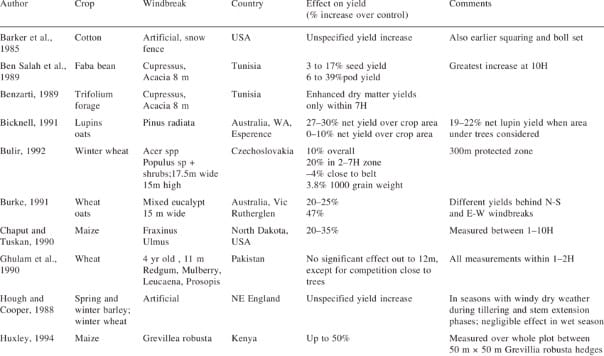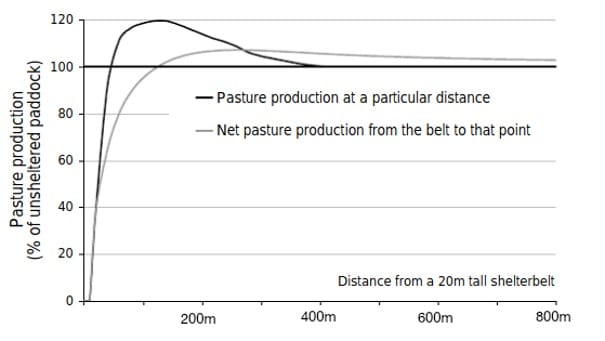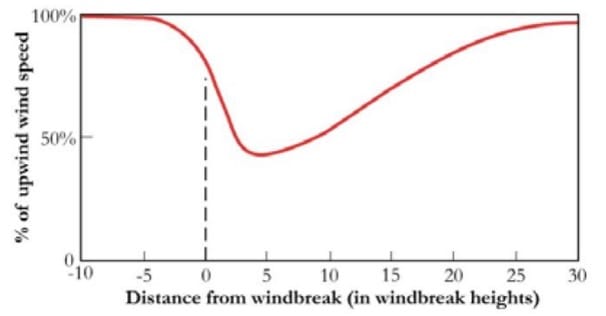Simply put, shelterbelts (aka windbreaks) are two or more rows of trees and shrubs. They can offer your farm several advantages.
In this article, I will tell you why you need tree shelterbelts on your farm. If you know the advantages and want to help designing shelterbelts for maximum efficiency, check this guide out here.
But, I don’t want trees on my farm…
First, let me address a common misconception. Many farmers don’t want trees on their farm, because they think trees will reduce pasture and crop yields. Crop farmers that grow corn, rice and wheat have extreme opinions about this.
For a moment, let’s take a step back. Let me help you explore some facts and turn to some science.
Yes, all plants need sunlight to grow well. Grass family plants such as corn, rice, wheat, rye and millets all need abundant sunshine. And yes, a lot of trees on the property can cut sunlight out.
But stop extrapolating these two facts to conclude that trees harm crop production. That’s an exaggeration at best.
I agree that there is very little grass in the woods and there are very few trees in meadows. But, there is a lot of middle ground between these two extreme examples that can give you the best of both worlds.
With trees on 8% to 15% of your property, you will lose very little and would gain a lot. You would have more healthy animals, better yields and reduce several risks.
Let me explain by covering the following:
1. Shelterbelts and healthy animals
2. Shelterbelts and increased yields
3. Shelterbelts can reduce heat stress
4. Shelterbelts reduce wind speeds
5. Shelterbelts may help you prevent large scale fire outbreaks
6. Shelterbelts can prevent waterlogging
7. Shelterbelts, microclimates and other by-products
8. Shelterbelts create resilient farms

1. Shelterbelts and healthy animals
As a progressive livestock farmer, you are always looking to maximize your gains. Shelterbelts can help you improve the health and productivity of your animals.
Haven’t you seen your animals huddle under that single tree on a hot day? Or huddle up against each other when a cold winter wind blows their way?
Your animals need to protect themselves from direct heat, dry, hot summer winds and cold winter winds. In a farm context, shelterbelts can provide this much-needed buffer from the elements.
Also, as I explain next, your animals will thrive when they have healthy pastures and lower risks.
2. Shelterbelts and increased yields
Several studies now show how rows of trees increase pasture and crop yields, significantly. [1], [2]
But how is this possible? Doesn’t lesser growing area and sunlight mean lesser production? Wrong. Nature doesn’t work in a linear way like that.

In reality, trees protect pasture and crops from heat, cold and high wind speeds. So they end up spending lesser energy dealing with harsh elements and instead use this energy to produce more.
This is why ten to fifteen percent of trees on your land can increase your dry matter yields per hectare.
Also, the sun moves from east to west through the day. So, your pasture or crops would not be under the shade, the entire day. Depending on the time of day and their location, they would get enough sunlight for at least a few hours.
This is all they need to thrive. And this also why having more than fifteen percent of your land covered in trees can start lowering your yields.
A research paper by Bird in 1998, found that pasture production increased significantly in areas that were less than 400 meters away from shelterbelts.

That should settle this discussion conclusively, I think. Let me carry on.
3. Shelterbelts can reduce heat stress
Imagine yourself standing for hours together directly under the hot sun. After a while, you would naturally find some shade, most probably under a tree. We are hard-wired to save ourselves from direct heat and dehydration. Animals included.
Today, it is well documented that heat stress can lower both milk as well as meat production in animals. And here are some numbers.
Bernabucci et al. (2010) reported that you could lose around 0.27 kilograms of milk, incrementally, with the rise of each temperature-humidity index unit.
Morignat et al. (2015)observes that heat stress increase as much as 1 °C above a particular threshold, increases mortality rates of dairy cows by 5.6% and beef cattle by 4.6%.
Here’s something for you to try. On a hot sunny day, take soil temperatures in the open field as well as under a cluster of large trees. You will find that trees can significantly lower temperatures.
A few degrees in temperature can be the difference between feeling comfortable and suffering from heat stress. Shelterbelts can do an excellent job of reducing heat stress effects.
4. Shelterbelts reduce wind speeds
As discussed earlier, plants need to spend energy to deal with high wind speeds and lose out production opportunities. Well-designed shelterbelts can decrease wind speeds by up to fifty percent. Because of this, shelterbelts are also known as windbreaks.
According to Rowan Reid, shelterbelts reduce wind speeds by up to 50% for areas within a specific range. This range is often expressed with respect to shelterbelt height.

So, a shelterbelt that is approximately 20 meters tall can significantly reduce wind speeds for an area that is up to 300 meters away from it (15 times the shelterbelt height).
Ideally, you want shelterbelts approximately every 300 meters on your farm.
5. Shelterbelts may help you prevent large scale fire outbreaks
As you know already, we are susceptible to large scale fire outbreaks during summer. This poses a significant threat to your farm.
Well maintained, green shelterbelts can help you cut off raging fires and prevent them from causing extensive damage because fire can only use dry material as fuel.
A barrier of dense green trees can significantly lower the damage of a fire outbreak.
6. Shelterbelts can prevent waterlogging
Yes, shelterbelts can help you effectively deal with those messy, wet and slushy parts of your farm.
These can be ideal locations for your shelterbelts if you carefully select water-logging tolerant tree species. Over time, the shelterbelts will improve your soil structure, add more carbon and help absorb all the excess moisture.
7. Shelterbelts, microclimates and other by-products
Microclimates are small pockets of area that have conditions opposite to the overall weather. Well established trees can buffer both heat and cold. This is why shelterbelts can give you and your animal's cool spots on hot days and relatively warmer zones on cold, windy days.
Also, well-designed shelterbelts can offer you other valuable by-products and services. To name a few, it can give you fruit, nuts, honey, game meat, pollinators, and biological pest infestation control services.
8. Shelterbelts create resilient farms
Shelterbelts become natural habitats for a range of diverse animals, birds, and insects. Such a healthy living ecosystem can help you better deal with pest and infection outbreaks.
It can also help you maintain and over time, cultivate more beneficial soil organisms. To sum it up, it helps you be more resilient.
This brings us to an end and I trust that this was useful to you. If so, please do share it with fellow farmers you know.
If you have any questions about shelterbelts or about improving your pasture, let me know in the comments below. I will personally answer them.
Happy Farming!
- The Dedicated Team of Pasture.io, 2020-04-14